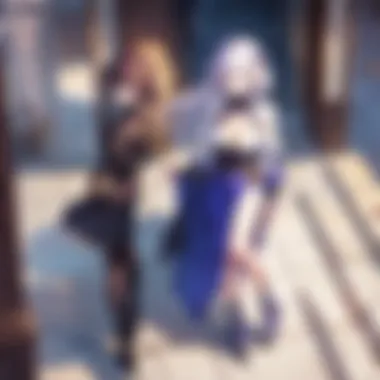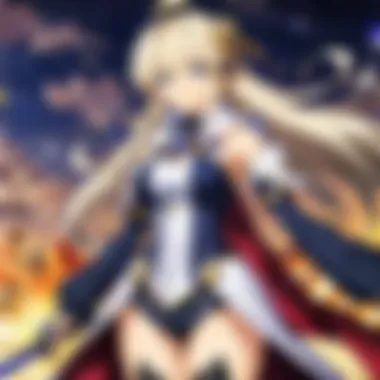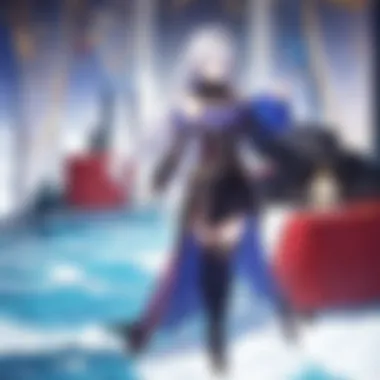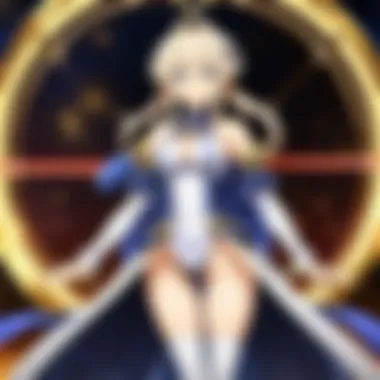Fate Grand Order Anime: A Deep Dive into Themes and Impact


Intro
Fate Grand Order has emerged as a prominent anime series that connects historical figures and mythical heroes through engaging storytelling. As viewers immerse themselves in this universe, the intricate themes and character dynamics come to the forefront. The narrative weaves myths from different cultures, presenting characters like King Arthur and Cleopatra in unique ways that spark curiosity and discussion. This article investigates the nuances of Fate Grand Order by exploring its episodes, character development, and the cultural ramifications it holds within anime.
With a focus on both the anime and its roots in the Fate franchise, this analysis aims to provide insights into specific episodes, character traits, and the reception of the series among fans. Additionally, it will highlight the series' adaptation from the visual novel format and its impact on the anime industry. As the series unfolds, we uncover underlying themes that resonate with audiences, ultimately shaping its cultural legacy.
Prelims to Fate Grand Order
The analysis of Fate Grand Order is crucial to understanding its profound impact within the anime and gaming realms. This section serves to highlight not only the origins and contextual foundations of the series but also its evolution in response to audience expectations and cultural shifts. Given the intricate nature of its narrative and character dynamics, this overview will set the stage for further exploration into its thematic elements and cultural significance.
Origins and Development
Fate Grand Order originated from a mobile game developed by Delightworks, with initial release in 2015. It is part of the larger Fate franchise, which has its roots in visual novels and expansions into various media forms. The initial concept was to create an interactive experience where players embody a "Master" who summons historical and mythical figures referred to as "Servants." This mechanic allows for engaging gameplay that intertwines a rich narrative with player choice. Over the years, the game has received numerous updates, expansions, and adaptations. Each new element has been carefully designed to enhance the storytelling and gameplay, thus continually attracting new players as well as catering to long-time fans.
Overview of the Series
The Fate Grand Order anime adaptation builds upon the extensive lore established in the game. The narrative revolves around themes of time travel, ethical dilemmas, and the nature of heroism. The series masterfully blends complex characters from different cultural backgrounds, showcasing their stories while also immersing viewers in a world where history and mythology intersect. This cross-cultural interplay not only contributes to a richer viewing experience but also reinforces the franchise's commitment to exploring diverse themes. Each character introduced serves a unique role in the overarching plot, providing audiences with multilayered perspectives on issues related to power, fate, and human aspiration.
"Fate Grand Order provides a unique blend of interactivity in its gaming format while expanding its narrative depth in the anime adaptation, capturing the interest of fans across the globe."
The series has gained notoriety not just for its engaging storylines, but also for its high-quality animation and character design, making it a standout in the anime industry. As audiences delve deeper into the universe of Fate Grand Order, it becomes clear that both its origins and the developmental journey are instrumental in shaping the narrative's complexity. This sets a solid groundwork for understanding the narratives that follow.
Narrative Structure
The narrative structure in Fate Grand Order plays a crucial role in shaping the overall experience for viewers. Understanding the way the plot unfolds and the techniques used within the story deepens appreciation for the artistic and thematic elements at play. The series employs a multi-layered framework that intertwines history, mythology, and original storytelling. Each arc presents its own vignette while contributing to the larger narrative tapestry.
Plot Constructs
The plot constructs of Fate Grand Order consist of distinct arcs, each exploring different themes and settings. These arcs are not just isolated stories; they often reflect on larger human experiences and philosophical questions. The series is known for its elaborate world-building, where historical and mythological figures interact with original characters. For instance, the ability to summon heroic spirits creates a dynamic that allows viewers to explore relationships between iconic figures in unique situations.
Key elements of plot construction include:
- Character Interactions: Relationships and conflicts among characters drive the story forward. Each character’s backstory is intricately woven into the narrative, creating depth.
- Thematic Depth: Themes such as heroism, morality, and tragedy are central, offering viewers food for thought.
- Evolving Complexity: The plot does not follow a linear path. It twists and turns, often surprising the audience with unexpected developments. This complexity invites viewers to engage deeply with the storyline.
By employing these constructs, Fate Grand Order captivates its audience, illustrating moral ambiguities and choices faced by characters as they navigate their quests.
Time Travel and Its Implications


Time travel is a significant device used in Fate Grand Order, allowing characters to traverse various historical periods. This enables the series to explore events and cultures through the lens of its characters. The implications of time travel are manifold, serving to enhance both character development and plot progression.
The following aspects highlight the importance of time travel:
- Ripple Effects: Changes made in one time period can create consequences in others. The exploration of these ripple effects stimulates discussions about causation and fate.
- Historical Exploration: By diving into historical contexts, the anime not only entertains but educates viewers about various civilizations and their narratives.
- Character Growth: Characters often face moral dilemmas prompted by their interactions in different timelines, fostering significant development and change.
In summary, the narrative structure of Fate Grand Order incorporates sophisticated plot constructs alongside time travel elements, both enriching the viewing experience and inviting philosophical reflection. As each story unfolds, audiences encounter a complex intermingling of destiny, choice, and the human condition.
Character Analysis
Character analysis is crucial in the exploration of Fate Grand Order anime. Characters are the lifeblood of any narrative, particularly in a series that intertwines various timelines and historical figures. Fate Grand Order offers a variety of characters that embody complex themes and personal struggles. Understanding these characters allows the audience to engage with the story on a deeper level. It also reveals how their individual journeys reflect broader cultural and philosophical principles.
Protagonists and Antagonists
The dichotomy between protagonists and antagonists in Fate Grand Order is sharply defined. The protagonists, primarily Servants and Masters, are tasked with achieving their goals while facing seemingly insurmountable challenges. They are designed not only to fulfill archetypical roles but also to evoke shades of humanity. Characters like Saber and Gilgamesh demonstrate the spectrum of good and evil, showing that motivations often lie beyond simple labels.
Protagonists often struggle with their purpose and the consequences of their decisions. For instance, the Master character faces moral dilemmas that put their ideals to the test. Contrastingly, antagonists such as Kirei Kotomine often embody nihilism and despair. This creates a narrative tension that keeps the audience invested through every twist. The interplay between these characters highlights the balance of power and personal accountability in an ever-shifting world.
Supporting Characters
Supporting characters play a pivotal role in enriching the narrative. They provide context and depth to the main storyline, often acting as foils or mentors. Figures like Mash Kyrielight serve not only as companions but also as catalysts for character development. Their interactions with the protagonists unveil layers of personality and backstory that might otherwise remain hidden.
There are also characters like Medea and Cú Chulainn, whose backstories intertwine with major events in both history and mythology. This gives them a multidimensional presence, making the audience question their motives and choices. Supporting characters can often bring critical insights to the main narrative, providing a broader understanding of the world of Fate Grand Order.
Character Archetypes and Evolution
The exploration of character archetypes in Fate Grand Order reveals a sophisticated approach to narrative development. Many characters represent established archetypes, such as the Hero, the Wise Mentor, or the Tragic Hero. However, what sets this series apart is the evolution of these archetypes over time. Characters undergo significant growth from their initial portrayal, addressing themes of redemption, power, and sacrifice.
For example, the character of Mordred transitions from a rebellious figure into one who understands the weight of her legacy. This progression showcases how characters are not static but rather evolve in response to their experiences and choices. The evolution of archetypes serves as a vehicle for illustrating the series’ thematic depth.
"In Fate Grand Order, character development is as much about individual journeys as it is about the collective narrative that binds them together."
Overall, character analysis dives into the heart of Fate Grand Order. It reveals the complexities of individual motivations and the intricacies of relationships that propel the narrative forward. By understanding the protagonists, antagonists, and supporting characters, audiences can appreciate the rich tapestry of themes and cultural influences embedded in the story.
Thematic Elements
The exploration of thematic elements in the Fate Grand Order anime is crucial for understanding its overall narrative and emotional resonance. The themes allow viewers to connect deeply with the story, elevating it from mere entertainment to a thought-provoking experience. Among these, notions of fate, sacrifice, redemption, power, and responsibility are prominent and weave a complex fabric that reflects human experience and philosophical inquiry.
Fate and Destiny


The theme of fate and destiny is central to the Fate Grand Order narrative. The characters are often entangled in destinies that they cannot control. Each story arc presents characters grappling with their predestined roles, as they venture through histories of both real and fictional figures. This constant struggle raises questions about free will. For example, the protagonist must often make choices influenced by preordained fate, illuminating how individual actions intersect with larger historical currents. The result is a narrative that challenges viewers to consider the extent of their autonomy amidst seemingly inescapable outcomes.
Sacrifice and Redemption
Sacrifice and redemption serve as powerful narrative devices in Fate Grand Order. Many characters face pivotal moments that demand personal sacrifice for the greater good. This theme resonates through the arcs of certain heroes, whose back stories reveal moments of failure or regret. These sacrifices often serve as a pathway to redemption, emphasizing that one's past does not define their present. The emotional weight of these choices elevates character development, making for a richer viewing experience. In various arcs, the most poignant moments occur when characters attain redemption through selflessness, prompting audiences to reflect on their own lives and potential for transformation.
Power and Responsibility
The interplay of power and responsibility is particularly salient in Fate Grand Order. Characters obtain great abilities, often referred to as Nobility Phantasms, which come with significant implications. With power comes the obligation to wield it wisely. This theme invites viewers to grapple with moral dilemmas faced by characters. Do they use their powers for selfish gain or for the betterment of others? These conflicts drive character motivations and decisions throughout their journeys. In many instances, the consequences of misuse of power reinforce the moral that true strength lies in self-restraint and moral integrity.
"In every choice, there is a universe of outcomes, tied to the fabric of fate."
Overall, the thematic elements of Fate Grand Order not only enrich its storytelling but also resonate with audiences on a personal level, prompting introspection about fate, sacrifice, and the ethical implications of power.
Cultural Context
Understanding the cultural context of Fate Grand Order is essential in grasping the anime's depth and richness. This section delves into the various layers of inspiration from mythology, history, and Japanese cultural elements that shape the narrative and character identities within the series.
Mythological Inspirations
Fate Grand Order heavily draws from a diverse range of mythologies. Each character in the series often embodies historical and legendary figures, which allows viewers to explore these myths in a modern context. Characters like King Arthur and Medusa present interpretations that reflect both traditional narratives and unique twists.
The series does more than just present these figures; it recontextualizes them, making them relatable to a contemporary audience. For instance, the character of Gilgamesh represents not just a Mesopotamian king but explores themes of ambition and divinity, bringing forth dilemmas that resonate with modern values and ethics.
Historical References
Incorporating historical references enriches the narrative structure of Fate Grand Order. Characters are often portrayed not merely in isolation, but as products of their time periods, contributing to their motivations and actions. This aspect allows the audience to engage with significant events and ideologies from different eras.
For example, the portrayal of figures such as Cleopatra and Jeanne d'Arc invites a deeper conversation about their legacies, which are often oversimplified in mainstream narratives. Their roles in the anime highlight the complexities of leadership and sacrifice. Viewers are encouraged to reflect on the consequences of ambition and the burdens of legacy.
Japanese Cultural Significance
Fate Grand Order also holds considerable significance in the context of Japanese culture. The series encapsulates elements of Japanese storytelling, such as the importance of fate and personal responsibility. These themes resonate deeply within the cultural fabric of Japan, where collective identity and the idea of predestined paths are often explored.
Moreover, the anime serves to highlight how Japan interprets and integrates foreign myths into its cultural landscape. It stands as a prime example of global storytelling, merging Eastern and Western elements. This blend not only broadens the appeal of the series but cultivates a dialogue between varying cultural narratives, enriching the anime genre as a whole.
"Fate Grand Order illustrates the ability of anime to bridge cultural divides, offering viewers a new lens through which to view classic narratives."


Impact on Anime Industry
The legacy of Fate Grand Order extends beyond its intricate storytelling and character development, influencing the broader anime landscape in several significant ways. Understanding its impact on the anime industry provides insight into the series' relevance and its role in shaping contemporary narrative forms, visual aesthetics, and audience engagement strategies.
Reception Among Audiences
Fate Grand Order has garnered a substantial following, establishing a unique position within the anime community. This series has earned accolades for its storytelling and character depth, effectively resonating with viewers.
- The audience response can be largely attributed to the show's ability to blend established historical figures with rich, constructed narratives.
- Viewers engage with the blend of myth and reality within the storylines.
- Positive reception is evident through high ratings on various platforms, as well as active discussions in online forums dedicated to anime.
One notable example of audience feedback comes from Reddit discussions where fans express their connection to the characters’ moral dilemmas and personal journeys. This engagement demonstrates that Fate Grand Order succeeds not only as a visual spectacle but also as an emotional catalyst.
Influence on Future Works
The Fate Grand Order phenomenon has set a precedent for future anime productions, especially regarding the incorporation of non-linear storytelling and the use of mythological themes. Many emerging anime creators now look to Fate Grand Order as a blueprint for narrative complexity and audience engagement.
- Themes of fate and choice in storytelling have become more prevalent in other series.
- The mix of visual novel elements with traditional anime formats opens new avenues for character development and plot construction.
- As a result, future works may explore the depth of existing myths or invent new mythologies that challenge perceptions of heroism and villainy.
Merchandising and Spin-offs
The commercial success of Fate Grand Order has led to extensive merchandising and numerous spin-offs. This aspect has demonstrated the potential of anime franchises to transcend their original narratives, reaching wider audiences through various mediums.
- Merchandise Examples:
- The series has inspired several mobile games, novels, and animated adaptations, each contributing to its robust brand ecosystem. This multi-faceted approach not only builds fan loyalty but also generates significant revenue.
- Figures
- Apparel
- Artbooks and soundtracks
Spin-offs like Fate/Extra and Fate/Apocrypha exemplify how secondary narratives can expand the universe established in the original series, enriching the lore while simultaneously drawing in new viewers. This approach has become increasingly common in the industry, as other franchises aim to replicate this success.
"Fate Grand Order serves as a testament to the potential of anime as a narrative form that can interlace various cultural elements, attracting diverse audiences."
Ending
The conclusion of this article serves to encapsulate the multifaceted impact of Fate Grand Order, summarizing essential insights accumulated through various sections. This series is more than just an anime or a mobile game; it is a cultural phenomenon. By examining its narrative, character dynamics, and thematic depth, we reveal the layers that make Fate Grand Order resonate with a diverse audience.
Summary of Key Points
Throughout the discussions, several key points emerged:
- Narrative Complexity: The series employs intricate plot constructs, interweaving time travel with themes of fate and destiny. This structure enriches the audience’s engagement and invites scrutiny of character motivations and arcs.
- Character Dynamics: Both protagonists and antagonists are crafted with careful attention to their histories and attributes, allowing for rich character development. Supporting characters also enhance the main storyline, providing depth.
- Cultural References: The infusion of mythological and historical figures serves not only to entertain but also to educate viewers about various cultures, signifying Fate Grand Order’s broad cultural footprint.
- Industry Influence: The series has profoundly impacted the anime landscape, influencing narrative styles and character portrayals in subsequent works. Its reception among fans highlights its popularity and lasting significance in contemporary animation.
Future Prospects for Fate Grand Order
Looking ahead, the future of Fate Grand Order seems promising. Several factors may shape its trajectory:
- Expanding Lore: The series can delve deeper into its rich lore, exploring untapped story arcs and characters that may engage existing fans while attracting new audiences.
- Technological Advancements: With the progress in animation technology, future adaptations can offer visually captivating experiences, maintaining the series’ appeal.
- Global Reach: As Fate Grand Order continues to gain international popularity, further localization and streamlined accessibility could broaden its fanbase.
- Merchandising Opportunities: The demand for products related to the series suggests that the merchandising market will continue to thrive, supporting the franchise financially.







